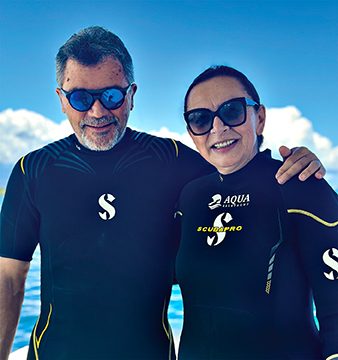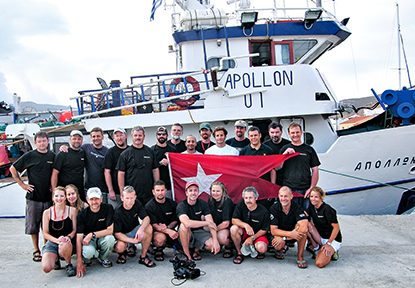PETAR DENOBLE, MD, D.SC., HAS DEDICATED HIS CAREER to exploring and solving practical issues in dive medicine. Born in Croatia, he learned to swim early and spent much of his free time freediving and fishing in the Adriatic Sea. Denoble graduated from the Zagreb University School of Medicine and then joined the Yugoslav navy to be involved in dive medicine.
How did you start working at DAN?
At 27 years old, I interviewed for a residency in internal medicine and learned about the Naval Diving Institute of the former Yugoslav navy. I was impressed with the hyperbaric department, their advanced equipment, and what they were doing. I joined the navy, not out of enthusiasm for the military but because I wanted to follow the path of dive medicine.
For three years I provided medical care, taught the physiology and medicine of diving, spent many days and nights at sea watching the safety of divers, and diving myself when all other divers were out of water. I later completed a residency in naval and dive medicine, postgraduate study, and a doctoral thesis in dive physiology.
While watching combat divers’ strenuous training, which not all candidates could complete, I started thinking about measuring the physiological cost of their activities and specific predictors of the suitability of candidates. When I transferred to a hyperbaric department and started my residency in naval and dive medicine, I was involved with a variety of practical research and the treatment of injured divers. Most cases were recreational divers with severe forms of decompression sickness (DCS). Observing frequent residual disability in severely injured divers furthered my interest in the prevention of dive injuries.
I joined DAN in late 1991, thanks to Peter Bennett, and worked under Richard Vann, who was faculty at the Duke Center for Hyperbaric Medicine and Environmental Physiology and the part-time director of research at DAN. While DAN had been conducting research at that point, most of it in the F.G. Hall Environmental Laboratory at Duke, I became the first full-time DAN researcher in February 1992, marking the official beginning of the DAN research department.
What project makes you most proud or one that you think about most fondly?
I like studies that aim to solve practical issues for divers, which is why I am especially fond of two DAN projects: the Dive Injury and Fatality Database, and Project Dive Exploration.
You may think that after centuries of diving we would know everything about what dive injuries can look like, but that’s not the case. Our mental model of decompression illness is quite simplified. Even artificial intelligence (AI) would have difficulties diagnosing DCS in real time because of the gaps in our knowledge. By working on a qualitative and quantitative description of DCS, we help improve our diagnostic abilities.
It’s also important to know how exposure affects the outcome. You’ll hear divers claim that because they didn’t breach standards set by decompression tables or their dive computer that their symptoms couldn’t be DCS, but that isn’t true. We know that there is a continuum of DCS risk from minimal to fatal. The risk is more predictable in severe decompression exposure than in relatively innocuous diving, like recreational diving should be. Yet we’ve witnessed that even in recreational diving, DCS can be unpredictably severe.
We started Project Dive Exploration (PDE) in 1995 to collect data about how recreational divers dive and how often they get DCS. PDE was effectively managed with the help of many volunteers and the dive industry. Dive computer manufacturers were kind enough to modify their software so we could retrieve their data. It was important to have precise information of a dive exposure to relate that to the outcomes. We previously had only hearsay and unverified reports of what dive caused what injury. Now we were able to get real, objective data and a measurement of dive exposures.
Dive computers were new on the market, so we needed tools to examine the data they could collect. At that time DAN did not have the funds to hire IT professionals, so it fell upon me to build an application that would help download dive profiles, collect postdive reports, and combine them with predive information. I knew a little bit of English but nothing about programming, so I received some tips from a knowledgeable friend and taught myself the rest. It was tedious work, especially debugging. It was never something I really liked, but it was an important part of the job.
Despite all the difficulties, we learned a lot of things. We confirmed that DCS is quite rare in recreational diving and established a baseline of incidence. We also confirmed that the exposure–outcome relationship is highly variable and that we would need more research to identify the drivers of that variability.
What is the role of collaborators and volunteers at DAN?
We’ve always relied on volunteers. It’s hard to establish a highly skilled lab with high capabilities to study multiple fields. Labs are usually specialized, but at DAN we don’t focus on only one issue or topic. We’re looking at the needs of divers in a broad sense. From doctors and physiologists to engineers and IT specialists, we need to collaborate with experts in various fields of research that align with our interests. We often are not the researcher ourselves — we’re the coordinator or inspirator of studies.
In a small organization such as DAN, we have to pick our fights and choose what we can do. I mostly worked on monitoring injuries and fatalities — trying to learn what issues need attention, engagement, and research. We would also run some studies that encompassed “orphan” issues that nobody could address at that time except for DAN.
The Flying After Diving research, for example, was a huge and expensive experimental study. With DAN’s support under Richard Vann, the participation of the entire Duke lab, and volunteer divers, the study lasted for years. In the end, we developed and published results that improved our knowledge of the risks of flying after diving and DCS prevention.
What are the most effective risk-mitigation strategies for scuba divers?
Scuba diving was demystified long ago, and to a certain extent maybe that was a mistake. What surprised me most during my time at DAN was how often divers get away with unsafe acts. I hesitate to say that because people might think they can get away with being unsafe, when in reality they are doing things that are well-documented to put them at risk.
Data like that isn’t an indicator of an unseen force watching out for drunkards and divers. Instead, it’s further proof of the Swiss cheese model of accidents. Unsafe acts create holes in your dive plan, and it only takes those holes aligning once to cause a devastating accident. The nature of these accidents makes it difficult for divers to grasp that they must always be on guard from unsafe acts.
That being said, I am not an advocate of raising participation barriers and restrictions. The DAN Research department and I have seen more dive injuries than anybody else, but in my view the data show that scuba generally is a safe activity. To make it safer, we must not let individual divers be careless; we must teach them. The only safe divers are the ones who are aware of the risks.
Predive checklists are an effective risk-mitigation tool with measured efficacy, but they are not a cure for everything. Risk-mitigation strategies should be customized for the type of dive activities and the diver profiles, and DAN does this by providing lifelong learning resources for both recreational and technical divers.
How else can we prevent dive fatalities?
By staying healthy and being aware of your limitations. I stopped diving in the 1980s back in Croatia. I had an episode of severe arrhythmia that scared me. While I admired and loved diving as a young man, after that I didn’t dare much to go underwater.
I once met a diver who had some serious heart arrythmia issues — she was banned from diving, and her physician labeled her as unfit to dive. Disregarding this, she bought a full-face mask so that theoretically, if she passed out underwater, she would not drown. Her dive buddy was her husband, and he was well-informed of her condition and location at all times. They continued to dive conservatively and never had any issues.
In most situations, people can find a way, but they have to be aware of their conditions and the risks involved to take proper risk-mitigation measures. I think people need to be honest with themselves. You can’t just pretend that you don’t have health issues when you do. It’s human to have your health naturally decline.
What does the future of dive research look like?
We need to learn more about what constitutes individual variability. Because nitrogen bubbles have a role in DCS, at least in describing severity of decompression stress, I would like DAN’s New Bubble Study on bubble variability within and between divers to be expanded. I hope the data that Frauke Tillmans and her team are collecting will help establish some other new methodologies and new tools, and we may eventually be able to get to customized decompression procedures.
We also need researchers. You will not find anything new in AI. It can summarize what is out there, but we as researchers must provide new information and take our research in new directions. AI can be a helpful tool; it can help you extract or analyze information from massive databases, but it will not generate or create new science.
The value of these new tools is that they can help you be more precise, more consistent, or faster while doing things. They can increase the impact of research, but researchers still have to lead the way. We can all appreciate technology — it can help a lot — but it’s still up to us to develop new ideas and to use the tools in the right ways. AD







© Alert Diver — Q2 2023